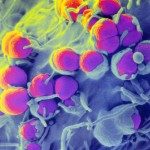Lien vers Pubmed [PMID] – 15749894
J. Immunol. 2005 Mar;174(6):3570-9
The chromosomal locus encoding the early secreted antigenic target, 6 kDa (ESAT-6) secretion system 1 of Mycobacterium tuberculosis, also referred to as “region of difference 1 (RD1),” is absent from Mycobacterium bovis bacillus Calmette-Guerin (BCG). In this study, using low-dose aerosol infection in mice, we demonstrate that BCG complemented with RD1 (BCG::RD1) displays markedly increased virulence which albeit does not attain that of M. tuberculosis H37Rv. Nevertheless, phenotypic and functional analyses of immune cells at the site of infection show that the capacity of BCG::RD1 to initiate recruitment/activation of immune cells is comparable to that of fully virulent H37Rv. Indeed, in contrast to the parental BCG, BCG::RD1 mimics H37Rv and induces substantial influx of activated (CD44highCD45RB(-)CD62L(-)) or effector (CD45RB(-)CD27(-)) T cells and of activated CD11c(+)CD11bhigh cells to the lungs of aerosol-infected mice. For the first time, using in vivo analysis of transcriptome of inflammatory cytokines and chemokines of lung interstitial CD11c+ cells, we show that in a low-dose aerosol infection model, BCG::RD1 triggered an activation/inflammation program comparable to that induced by H37Rv while parental BCG, due to its overattenuation, did not initiate the activation program in lung interstitial CD11c+ cells. Thus, products encoded by the ESAT-6 secretion system 1 of M. tuberculosis profoundly modify the interaction between mycobacteria and the host innate and adaptive immune system. These modifications can explain the previously described improved protective capacity of BCG::RD1 vaccine candidate against M. tuberculosis challenge.

